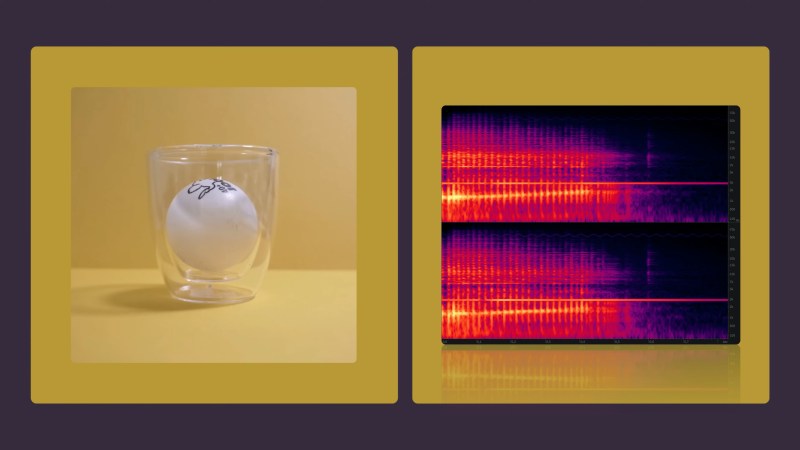[Iftah] has been exploring the sounds beyond what we can hear, recording ultrasound and pitching it down. He made a short video on the practice, and it’s like a whole new world of sounds exists just outside of our hearing.
For instance, a dropped toothpick sounds like you’ve just dropped a piece of lumber, a broken lightbulb sounds like a shattered window, and a blackbird sounds like a blue whale. Besides simply sounding super, [Iftah] speculates that there’s some regularity here: that as you slow down the sound it sounds like it came from sources that are physically bigger. He follows this up in a second video, but if you just think about the basic physics, it makes sense.
If you’re interested in recording your own ultrasound, there are a bunch of options on the market. With modern audio processors running up to 192 kHz or even 384 kHz out of the box, all that’s missing is the high-frequency-capable microphone. Those aren’t unobtainable anymore either with many MEMS mics performing well above their rated frequency response specs. Recording ultrasound sounds like a fun and not-too-expensive project to us!
Of course, most of the ultrasound recording we’ve seen has been about the bats. Check out the Pipistrelle or this pair of DIY bat detectors for some good background. But after watching [Iftah]’s video, we’re no longer convinced that the cute little insectivores are the coolest thing going on in the ultrasound.
















Interesting how everything sounds exactly like it would if the objects were much larger.
Interesting, but not surprising. Even in daily life you might notice that large humans tend to have deeper voices than small humans. More volume = space for larger resonant waves to build up.
Writing that bats are insectivores is like writing that all presidents eat only burgers.
Many bats species eat only fruits. Some other even feed on mammal blood. And yes, some eat insects.
As a sound designer, I’ve also done a lot of ultrasonic recordings, some unintentionally. One summer evening, I was trying to capture the sound of frogs and crickets. I had my recording levels set appropriately for those sounds. However, I was frequently seeing the level meters jump to full scale and the clipping indicators occasionally flashed. I thought I might have a faulty connection to my mics as I certainly wasn’t hearing anything that would cause that. When I got my recordings onto my edit machine in the studio, the meters in my DAW did the same thing and I could see the waveform had many very loud segments even though they sounded the same as the quieter parts. When I switched to a spectrogram view, I saw a lot of loud activity captured around 40 kHz and higher. It was bats. When slowed down a few octaves, it was very cool to hear these otherworldly bird-like sounds. Additionally, I heard the same echolocation phenomenon he describes where the individual chirps got closer together as the bat zeroed in on its target. It was similar to hearing a ball bearing bouncing on a hard surface as the delay between bounces converges to zero.
I would love a pair of headphones with ultrasonic mics in them that auto dropped the pitch of sounds so I could just walk around with them to see what I could hear.
I’m with you there. With the right frequency compression I think it could be done pretty comfortably without interfering with normal sound.
NE602(SA612, etc) + ultrasonic transducer make for very simple bat detector designs. Jingling keys, florescent lights, insects, so many cool sounds waiting to be observed!
where do you get your NE602(SA612, etc) been told they are obsolete by one supplier. and there seams to be no Chinese copy?
Always a fan of videos like that that get people thinking about how they perceive the world and all that goes on beyond the typical sensory ranges. Life seems like it is longing to be seen in new angles.
Getting new perspectives into sensory abstracts beyond the usual is a trip and a half, no matter the route taken. So much goes on beyond our observation, awareness at any given moment, be it in our own subconscious or the world external. Can’t think every thought in a single life, can’t have every perspective, let alone in any individual moment/time slice!
A wonderful world of interesting new perspectives, just beyond reach, aside from via technology. (Much like with many other things in life!).
That being said, it isn’t quite right to say we can’t hear it.
We can’t hear it via natural biology, sure, but we can via sensory substitution, expansion technologies.
These sorts of techniques (self-terming sensory weaving), take patterns from a source, digitize and then convert to another medium within our perceptual range – a common case is tactile, via haptic vibrations like those in a cell phone. After about a month, the mind will generate a “qualia” around it, a representation of the new sensory signal as though a native sense.
However, this doesn’t give the same sorts of views as the video demonstrated, vs different ones.
The ability to slow down, focus on specific elements and do more complex manipulation may not translate as well to direct perception, but still offers insights into a world of detail and mystery beyond our senses.
(because of the slowing it down aspect, it does also limit some types of investigation, vs using haptic vibration patterns to signal different intensities/frequencies of audio for example)
Hearing what bats hear is cool, exploring it and “seeing” it conceptually from angles even bats can’t as the video shows is super amazing. Sensing some extra perceptual manifold overlap to what they sense, directly is also pretty cool (subjectively, anyway – does require going a little “crazy” so not for everyone)